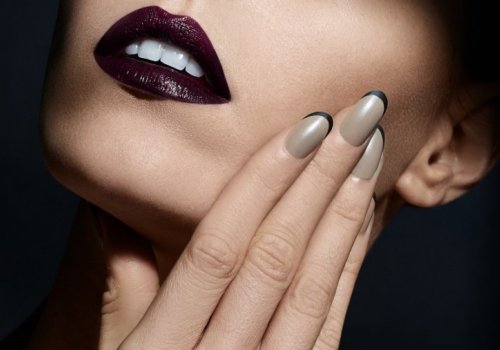
Whether you’re an at-home nail art junkie or you have a standing weekly manicure at the salon, one of the biggest issues to tackle when it comes to your nails is strength. Peeling, flaking, and breaking happens when nails are weak, and besides just being painful, weak nails are a hassle. We’ve all dealt with the issues, and while there are plenty of tips floating around out there — give your nails a breather every three weeks, use the strengthening top coat – we wanted some straight answers.
Dr. Chris G. Adigun, MD, FAAD, board-certified dermatologist, nail expert, and member of the Dermelect Board of Advisors was up to the challenge. Below, Dr. Adigun explains what causes weak nails, how to make nails stronger, and whether the myths out there are worth paying attention to.
Beauty High: What are some of the reasons nails become weak?
There are several factors that cause our nails to become dry and weak. The biggest factor is moisture loss. This can happen due to climate changes, such as the very dry weather in the winter in conjunction with the very drying indoor heating systems. It also commonly happens with excess exposure of the nails and hands to water and harsh substances such as cleaning solutions. Finally, any time that cuticles are cut, trimmed, or vigorously pushed back, the cuticle is not longer able to function and maintain moisture within the nail unit. As a result, the nails and surrounding skin will lose moisture to the surrounding air.
Moisture loss in the nail unit can cause problems to nail quality over time. Many of my patients come to me for evaluation of brittle nails or peeling nails. Often, these problems stem from chronic cuticle manipulation, such as pushing or trimming. I treat these patients with a rigorous rehydration regimen for their cuticles and nails, and explain the importance of maintaining healthy cuticles to maintain healthy nails.
Are there natural remedies for strengthening nails?
Paying special attention to keeping your hands, fingers, and entire fingertip (which includes the nail plate, surrounding skin of the nail, and cuticle) well moisturized is key. I often advise patients that have persistently dry nails and cuticles to wear cotton-lined rubber gloves when performing any kind of “wet work” (cleaning, dish washing) and to minimize excessive water exposure. When washing hands, I recommend immediate application of a heavy emollient to the nails and digits such as Aquaphor. As far as natural remedies, great occlusive and moisture-retaining agents include bees wax and shea butter. All of these can be excellent hydrators to the nails and nail units. I would add oils such as coconut oil and/or vitamin E oil as helpful for the cuticles, as these oils can get to tough-to-reach areas such as the hyponychium.
Do the strengthening top coats/polishes really work?
Yes, many of them can be very helpful by sealing moisture into the nail plate, allowing the nail plate to be more pliable and resilient to breakage. However, I do recommend to my patients with persistently dry nails to try top-coats and polishes geared to more sensitive nails (such as the 3-free polish options). For more severe cases, prescription products such as Nuvail and Genadur are necessary.
We often hear that women should take a break from nail polish to let their nails “breathe” every three weeks or so. Is this just a myth or should we be doing this? If so, how often would you recommend?
I definitely recommend to my patients to take short “manicure honeymoons” or go on “manicure diets” to give their nails a chance to have oxygen flow around and under the nail plate. There is another very important reason to remove the polish for a few days every several weeks. That is because it is important to see your nails, or “police” them for changes, infection, or other problems. People that have regular manicures, long-wearing manicures such as gels, or acrylic nails, may not see their nails, or what may be going on underneath them, for a month—or longer if they consistently have a new manicure put in place as soon as the old one is removed. It is important to observe your nails periodically (every 2-3 weeks is sufficient) to make sure that there are no changes that could be concerning for infection or even a tumor.
Does the direction of filing nails have any effect on the strength of nails?
It is highly unlikely that the direction of filing will have any effect on the overall strength of the nail plate. However, the technique of filing can affect the likelihood of splitting. Small ridges in the nail are individual points of weakness, and a sawing motion may cause these small ridges to crack, which will lead to a split nail. Dryer nails, in general, are very vulnerable to splitting and peeling. When filing thin, ridged, or dry nails, I recommend being as gentle as possible, and trying keep the filing in one direction.
Do you recommend any products for strengthening nails?
For stronger nails, I first recommend hydrating nails with heavy emollients, and taking meticulous care of your cuticles. Our cuticles nourish and protect our nails, so we must nourish and protect them! Apply Petroleum jelly, Aquaphor, Aveeno Healing Ointment, or Vaniply Ointment 2-3 times daily to the nails, cuticles, and surrounding skin, and apply nourishing cuticle oils, vitamin E oil, or coconut oil to the cuticles twice daily. I also recommend biotin 5 mg (or 5,000 micrograms) daily as a supplement. Nourishing polishes, preferably (at least) 3-free, applied immediately after moisturizing, can be very restorative and protective.



